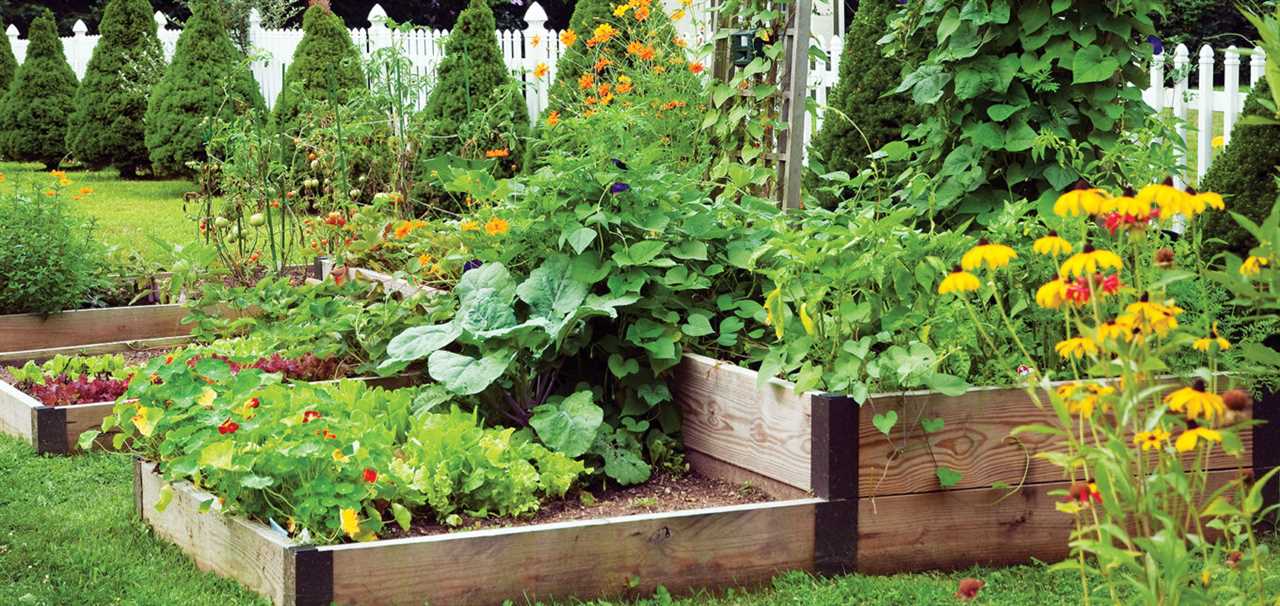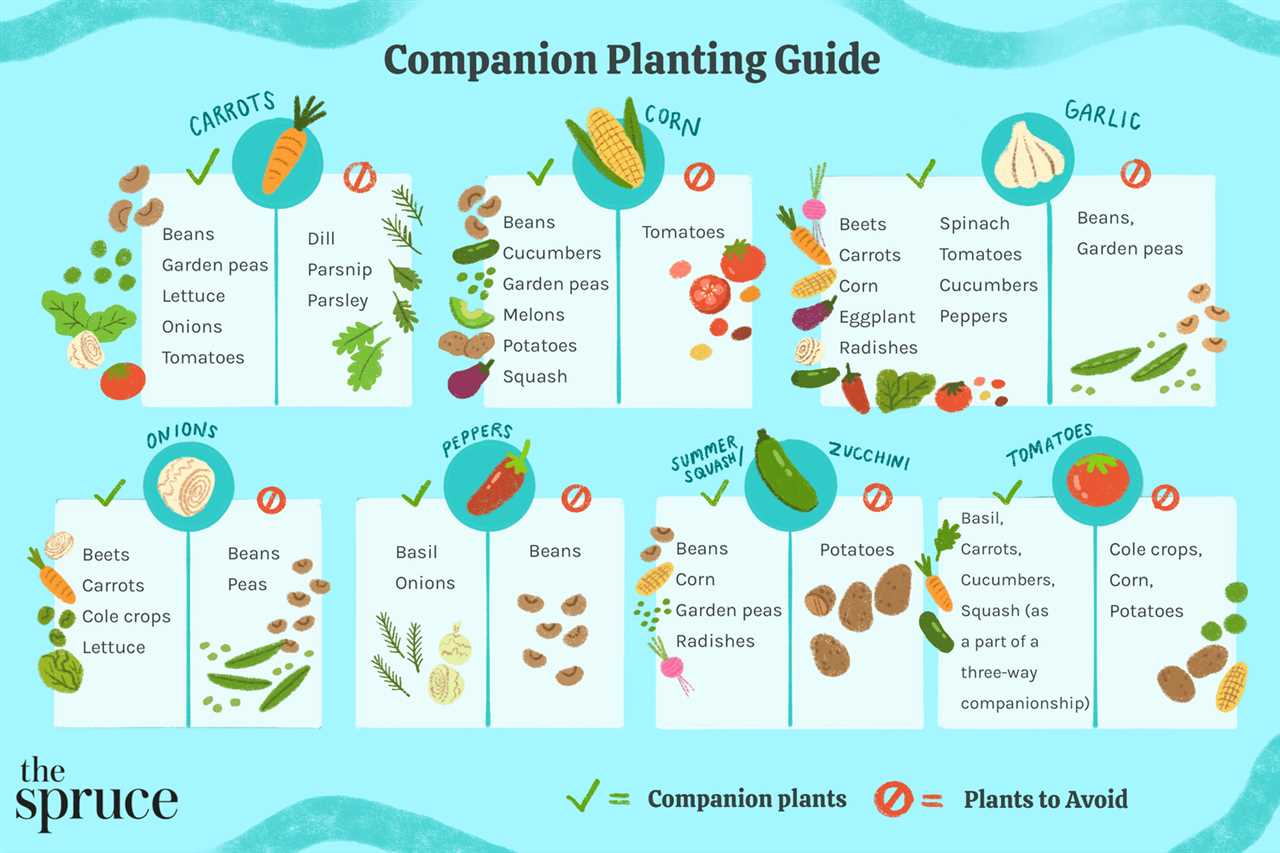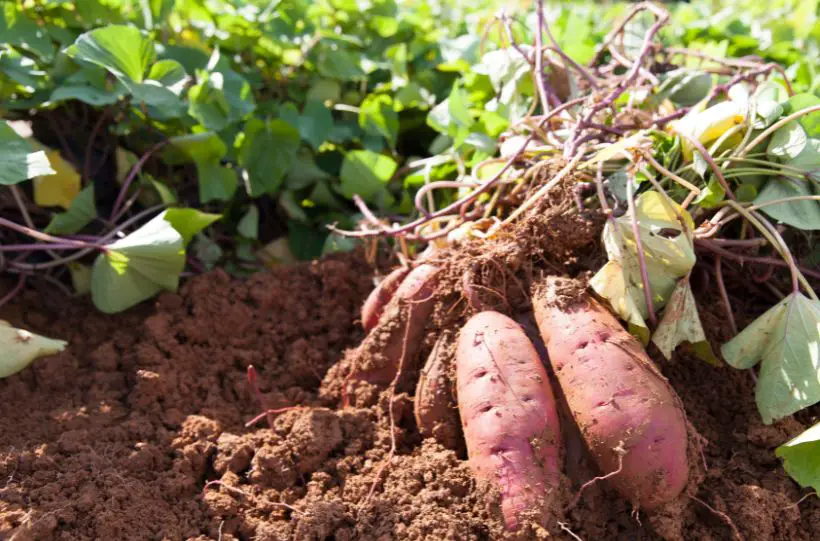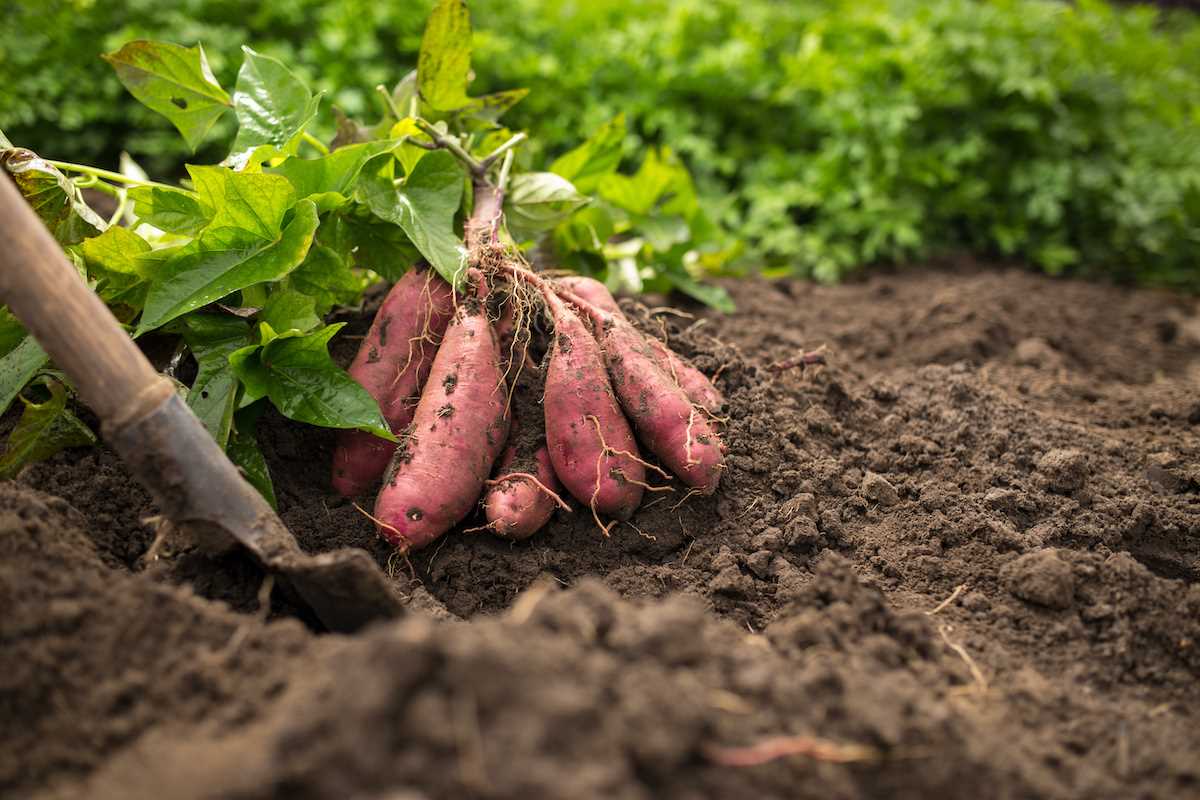Contents
Sweet Potato Companion Plants The Perfect Combinations for a Thriving Garden

When it comes to growing vegetables, the health of the soil and the plants themselves is of utmost importance. One way to ensure a thriving garden is by using companion plants. These are plants that are grown alongside each other to provide mutual benefits. In the case of sweet potatoes, there are several companion plants that can help improve their growth and yield.
Sweet potatoes are a popular choice for many gardeners due to their delicious taste and high nutritional value. However, they can be demanding when it comes to soil fertility. That’s where companion plants come in. By planting certain plants alongside sweet potatoes, you can enhance the soil quality and provide natural fertilizer.
One of the best companion plants for sweet potatoes is legumes, such as beans and peas. These plants have the ability to fix nitrogen in the soil, which is an essential nutrient for sweet potatoes. Additionally, legumes help improve soil structure and prevent erosion, making them an excellent choice for a sweet potato garden.
Another great companion plant for sweet potatoes is the marigold. Marigolds not only add a pop of color to your garden, but they also help repel pests that can damage sweet potato plants. Their strong scent acts as a natural deterrent for insects, making them an ideal companion for sweet potatoes.
In conclusion, choosing the right companion plants for your sweet potatoes can greatly enhance the health and productivity of your garden. By selecting plants that improve soil fertility, provide natural fertilizer, and repel pests, you can create the perfect environment for your sweet potatoes to thrive.
Benefits of Companion Planting with Sweet Potatoes

Companion planting is a gardening technique where different plants are grown together for mutual benefits. When it comes to sweet potatoes, companion planting can greatly enhance the health and productivity of your garden. Here are some of the benefits of companion planting with sweet potatoes:
- Improved soil: Sweet potatoes have deep roots that can break up compacted soil, improving its structure and allowing for better drainage. Additionally, they are known for their ability to suppress weeds, reducing competition for nutrients and water in the soil.
- Increased vegetable yield: Sweet potatoes are excellent companions for many vegetables. They release substances into the soil that can enhance the growth and yield of neighboring plants. By interplanting sweet potatoes with other vegetables, you can significantly increase your overall harvest.
- Natural pest control: Sweet potatoes have natural pest-repellent properties, making them a great companion for plants that are susceptible to pests. They emit chemicals that deter insects such as aphids and nematodes, reducing the need for chemical pesticides.
- Enhanced flavor: Some vegetables, such as tomatoes and peppers, have been found to have improved flavor when grown near sweet potatoes. The sweet and earthy aroma of sweet potatoes can enhance the taste of these vegetables, making them even more delicious.
- Space utilization: Sweet potatoes are vining plants that can spread out and cover a large area. By interplanting them with other vegetables, you can maximize your garden space and make efficient use of limited growing areas.
When choosing companion plants for sweet potatoes, consider plants that have similar growing requirements and complement each other in terms of height, sun exposure, and water needs. Some good companion plants for sweet potatoes include beans, corn, kale, and lettuce.
Overall, companion planting with sweet potatoes can help create a thriving and productive garden. By carefully selecting the right companion plants, you can improve soil health, increase vegetable yield, control pests naturally, enhance flavor, and make efficient use of garden space. Give it a try and enjoy the benefits of this symbiotic gardening technique!
Increased Pest Resistance

Growing sweet potatoes in your garden can attract pests that can damage your harvest. However, by planting certain companion plants alongside your sweet potatoes, you can increase their pest resistance and protect your crop.
Companion plants such as marigolds, mint, and basil can help repel pests that are attracted to sweet potatoes. These plants emit strong scents that deter insects like aphids, beetles, and nematodes. Planting these companion plants in close proximity to your sweet potatoes can create a natural barrier against pests.
In addition to repelling pests, some companion plants can also attract beneficial insects that prey on pests. For example, planting dill or parsley near your sweet potatoes can attract ladybugs and lacewings, which feed on aphids and other harmful insects. This natural form of pest control can help keep your sweet potato plants healthy and free from infestations.
Furthermore, certain companion plants can improve the overall health of your sweet potato plants, making them more resistant to pests. Legumes like beans and peas can fix nitrogen in the soil, providing a natural fertilizer for your sweet potatoes. This nitrogen-rich environment helps the sweet potatoes grow strong and healthy, making them less susceptible to pest attacks.
It’s important to choose companion plants that have similar growing requirements to sweet potatoes. They should prefer the same soil type, sunlight, and watering needs. By selecting compatible companion plants, you can create a harmonious garden ecosystem that supports the growth and pest resistance of your sweet potatoes.
| Companion Plants | Pest-Repelling Properties | Beneficial Insects Attracted |
|---|---|---|
| Marigolds | Repel aphids and nematodes | – |
| Mint | Repel beetles and aphids | – |
| Basil | Repel flies and mosquitoes | – |
| Dill | – | Attract ladybugs and lacewings |
| Parsley | – | Attract ladybugs and lacewings |
| Beans | – | – |
| Peas | – | – |
By incorporating these companion plants into your sweet potato garden, you can enhance the pest resistance of your crop and ensure a thriving harvest.
Enhanced Soil Health

When it comes to growing sweet potatoes, having healthy soil is essential. By incorporating companion plants into your garden, you can enhance the health of your soil, leading to a bountiful harvest of sweet and nutritious potatoes.
One way to improve soil health is by using companion plants that act as natural fertilizers. These plants have the ability to fix nitrogen in the soil, which is an essential nutrient for the growth of vegetables, including sweet potatoes. Some common nitrogen-fixing companion plants include legumes such as beans and peas.
Another way to enhance soil health is by using plants that have deep root systems. These plants help to break up compacted soil and improve its structure. Sweet potatoes themselves have deep root systems, making them an excellent choice for improving soil health. Other plants with deep roots that can be grown alongside sweet potatoes include comfrey and sunflowers.
In addition to nitrogen-fixing and deep-rooted plants, there are also plants that can help suppress weeds and prevent soil erosion. By planting companion plants that have dense foliage, such as marigolds or buckwheat, you can create a natural mulch that helps to smother weeds and protect the soil from erosion.
By incorporating a variety of companion plants into your sweet potato garden, you can create a diverse and balanced ecosystem that promotes soil health. The plants will work together to improve soil fertility, prevent nutrient depletion, and provide a natural defense against pests and diseases.
| Companion Plant | Benefits |
|---|---|
| Beans | Fix nitrogen in the soil |
| Peas | Fix nitrogen in the soil |
| Comfrey | Deep root system improves soil structure |
| Sunflowers | Deep root system improves soil structure |
| Marigolds | Suppress weeds and prevent soil erosion |
| Buckwheat | Suppress weeds and prevent soil erosion |
By following these companion planting guidelines, you can ensure that your sweet potatoes have the best possible growing conditions. Not only will your soil be healthier, but you will also enjoy a more productive and abundant harvest of delicious sweet potatoes.
Improved Yield and Quality

When it comes to growing sweet potatoes, companion planting can significantly improve both the yield and quality of your harvest. By strategically planting certain plants alongside your sweet potatoes, you can create a beneficial environment that promotes healthy growth and minimizes pests and diseases.
One of the most important factors in achieving improved yield and quality is selecting the right companion plants. Certain plants can help to naturally fertilize the soil, provide shade, attract beneficial insects, or repel harmful pests. These interactions can enhance the overall health and productivity of your sweet potato plants.
Companion plants that are known to provide natural fertilizer include legumes such as beans and peas. These plants have nitrogen-fixing bacteria in their roots, which can enrich the soil with nitrogen, an essential nutrient for sweet potatoes. By interplanting legumes with sweet potatoes, you can create a symbiotic relationship that benefits both plants.
In addition to nitrogen-fixing plants, there are several vegetables that can be planted alongside sweet potatoes to improve their yield and quality. Some examples include tomatoes, peppers, and kale. These plants can provide shade to the sweet potato vines, which helps to regulate soil temperature and moisture levels. They can also attract beneficial insects like bees and ladybugs, which can help with pollination and pest control.
On the other hand, there are certain plants that should be avoided as companions for sweet potatoes. These include other root vegetables like carrots and onions, as they may compete with sweet potatoes for nutrients and space. Additionally, plants from the nightshade family, such as tomatoes and peppers, should be avoided if you are concerned about potential disease transmission.
In summary, companion planting is a valuable technique for improving the yield and quality of sweet potatoes. By selecting the right companion plants and avoiding incompatible ones, you can create a harmonious garden ecosystem that benefits all plants involved. So, why not try interplanting some vegetables alongside your sweet potatoes and see the difference it makes in your harvest?
Best Companion Plants for Sweet Potatoes

Sweet potatoes are a delicious and nutritious vegetable that can be a great addition to your garden. They are easy to grow and can be harvested in the fall. To ensure a successful harvest, it’s important to choose the right companion plants for your sweet potatoes. Companion plants can help improve the soil, deter pests, and enhance the growth of your sweet potatoes.
Here are some of the best companion plants for sweet potatoes:
- Beans: Beans are excellent companions for sweet potatoes as they help fix nitrogen in the soil. This nitrogen fixation can provide a natural fertilizer for the sweet potato plants, promoting their growth.
- Garlic: Garlic is a natural pest deterrent and can help keep pests away from your sweet potatoes. Planting garlic near your sweet potatoes can help protect them from pests like aphids and spider mites.
- Onions: Onions are another great companion plant for sweet potatoes. They can help deter pests and improve the flavor of your sweet potatoes.
- Marigolds: Marigolds are known for their pest-repellent properties. Planting marigolds around your sweet potatoes can help keep pests like nematodes and aphids away.
- Spinach: Spinach is a great companion plant for sweet potatoes as it can help provide shade and reduce competition for nutrients in the soil.
- Mint: Mint is a natural pest deterrent and can help keep pests away from your sweet potatoes. Planting mint near your sweet potatoes can also help improve the flavor of your harvest.
When choosing companion plants for your sweet potatoes, it’s important to consider their growth habits and compatibility. Avoid planting companion plants that require the same amount of space or have similar nutrient requirements as sweet potatoes.
By choosing the right companion plants for your sweet potatoes, you can create a thriving garden and enjoy a bountiful harvest of delicious and nutritious vegetables.
Marigolds

Marigolds are a sweet addition to any garden. These beautiful flowers not only add a pop of vibrant color, but they also have several benefits for sweet potato plants.
Marigolds are known for their ability to repel pests, such as nematodes, which can be harmful to sweet potato plants. By planting marigolds near your sweet potato plants, you can help protect them from these pests and ensure a healthier harvest.
In addition to their pest-repellent properties, marigolds also act as a natural fertilizer. They release a chemical into the soil that helps improve its fertility, making it more suitable for sweet potato growth. This can result in larger and healthier sweet potatoes.
Marigolds are also a great companion plant for sweet potatoes because they help to improve soil structure. Their roots help to break up compacted soil, allowing for better drainage and root growth. This can prevent issues such as root rot and ensure that your sweet potato plants receive the nutrients they need.
When planting marigolds with sweet potatoes, it is best to interplant them throughout the garden rather than in one specific area. This will help to spread their benefits evenly and provide maximum protection and fertility for your sweet potato plants.
Companion Planting with Marigolds

Here are some companion plants that pair well with marigolds and sweet potatoes:
- Beans: Beans help to fix nitrogen in the soil, which can benefit both marigolds and sweet potatoes.
- Mint: Mint repels pests and can help to deter rodents that may be attracted to sweet potato plants.
- Oregano: Oregano is a natural pest repellent and can help to keep pests away from both marigolds and sweet potatoes.
- Thyme: Thyme has antimicrobial properties that can help to prevent diseases in both marigolds and sweet potatoes.
By planting marigolds alongside these companion plants, you can create a thriving garden that benefits all of your plants. The marigolds will provide protection and fertility for your sweet potatoes, while the companion plants will further enhance their growth and health.
| Companion Plant | Benefits |
|---|---|
| Beans | Fix nitrogen in the soil |
| Mint | Repels pests and deters rodents |
| Oregano | Natural pest repellent |
| Thyme | Antimicrobial properties |
Overall, marigolds are a fantastic companion plant for sweet potatoes. They provide pest control, natural fertilizer, and improved soil structure, all of which contribute to a thriving garden and a bountiful sweet potato harvest.
Beans

Beans are a great companion plant for sweet potatoes. They help improve the soil by fixing nitrogen, which is an essential nutrient for plant growth. The nitrogen-fixing ability of beans benefits not only the sweet potatoes but also other vegetables in the garden.
When planting beans with sweet potatoes, it is important to consider the timing. Beans can be planted at the same time as sweet potatoes, and they will grow together throughout the season. This allows the two plants to support each other and maximize their growth potential.
One of the main benefits of planting beans with sweet potatoes is that they help control weeds. The dense foliage of the beans shades the ground, preventing weed growth and reducing competition for nutrients and water. This makes it easier to maintain a clean and healthy garden.
In addition to weed control, beans also provide a natural trellis for the sweet potato vines to climb. This helps keep the sweet potatoes off the ground, preventing rot and damage. The beans and sweet potatoes together create a vertical garden that maximizes space and allows for a more efficient use of resources.
Another advantage of planting beans with sweet potatoes is that they attract beneficial insects. Beans produce flowers that attract pollinators, such as bees and butterflies. These insects help pollinate the sweet potato flowers, resulting in a better harvest.
When it comes to fertilizing, beans and sweet potatoes have different needs. Beans prefer a well-fertilized soil, while sweet potatoes do not require as much fertilizer. It is important to provide the right balance of nutrients for both plants to thrive.
| Benefits of planting beans with sweet potatoes: |
|---|
|
Overall, planting beans with sweet potatoes is a win-win situation. The two plants complement each other and create a thriving garden environment. So, if you are planning to grow sweet potatoes, consider planting beans as their companion for a successful harvest.
Nasturtiums

Nasturtiums are a great companion plant for sweet potatoes in the garden. These beautiful and vibrant flowers not only add color and beauty to your vegetable garden, but they also provide several benefits for your sweet potatoes.
Companion Benefits:
- Nasturtiums act as a natural pest repellent, especially against aphids and whiteflies, which can be harmful to sweet potato plants.
- Their strong scent can also help deter other pests, such as squash bugs and cucumber beetles.
- Nasturtiums attract beneficial insects, like ladybugs and bees, which can help pollinate your sweet potato plants and improve their overall health.
- These flowers can also act as a trap crop, luring pests away from your sweet potatoes and protecting them from potential damage.
Planting and Care:
When planting nasturtiums as companion plants for sweet potatoes, it’s best to sow the seeds directly into the soil after the danger of frost has passed. They prefer well-drained soil and full sun, but can tolerate partial shade.
Make sure to space the seeds or seedlings about 10-12 inches apart to give them enough room to grow. Nasturtiums are known for their trailing and climbing nature, so providing them with some support, like a trellis or fence, can help them thrive.
These flowers are relatively low-maintenance and don’t require much fertilizer. In fact, too much fertilizer can result in more foliage growth and fewer flowers. However, adding some compost or well-rotted manure to the soil before planting can provide them with the necessary nutrients.
Harvesting:
Nasturtiums are not typically grown for their edible parts, but they do have edible flowers and leaves. The flowers have a sweet, peppery flavor and can be used to garnish salads or other dishes. The leaves can also be added to salads or used as a substitute for basil in pesto.
Conclusion:
By planting nasturtiums alongside your sweet potatoes, you can create a thriving garden that not only looks beautiful but also benefits both plants. The natural pest-repellent properties of nasturtiums and their ability to attract beneficial insects make them an excellent companion for sweet potatoes. So, consider adding these vibrant flowers to your garden and enjoy the benefits they bring!
Companion Plants to Avoid

While companion planting can greatly benefit your sweet potato garden, there are some plants that should be avoided as they can have a negative impact on the growth and harvest of your sweet potatoes.
1. Potatoes: Avoid planting regular potatoes near your sweet potatoes as they can compete for nutrients and space. Both plants require similar soil conditions and can lead to stunted growth and a smaller harvest.
2. Sweet Peas: While sweet peas are often used as a companion plant for other vegetables, they should be avoided in a sweet potato garden. Sweet peas are nitrogen-fixing plants, which means they take nitrogen from the air and convert it into a form that can be used by other plants. However, sweet potatoes prefer low nitrogen levels, so planting sweet peas nearby can lead to an excess of nitrogen in the soil, resulting in lush foliage but fewer sweet potatoes.
3. Other Root Vegetables: Avoid planting other root vegetables, such as carrots, radishes, and beets, near your sweet potatoes. These plants can compete for space and nutrients, leading to smaller sweet potatoes. Additionally, root vegetables can attract pests that may also damage your sweet potato plants.
4. Vining Plants: Avoid planting vining plants, such as cucumbers, melons, and squash, near your sweet potatoes. These plants can quickly spread and overshadow the sweet potato vines, reducing their access to sunlight. Sweet potatoes require a lot of sunlight to grow and thrive, so it’s best to keep them away from vining plants.
5. Invasive Plants: Be cautious of planting any invasive plants near your sweet potatoes. Invasive plants can quickly take over your garden and outcompete the sweet potatoes for resources. Examples of invasive plants to avoid include mint, lemon balm, and comfrey.
By avoiding these companion plants, you can ensure that your sweet potatoes have the best chance of thriving in your garden. Remember to plan your garden layout carefully and consider the needs of your sweet potatoes when choosing companion plants.
Irish Potatoes

Irish potatoes, also known as white potatoes or simply potatoes, are a popular vegetable that can be grown in home gardens. They are a versatile crop that can be used in a wide variety of dishes and are a staple in many cuisines around the world.
Growing Irish potatoes requires well-drained soil that is rich in organic matter. The soil should be loose and friable to allow the potatoes to grow and expand easily. It is important to prepare the soil before planting by removing any rocks, weeds, or other debris that may hinder the growth of the potatoes.
When it comes to fertilizing Irish potatoes, it is best to use a balanced fertilizer that contains equal amounts of nitrogen, phosphorus, and potassium. This will provide the potatoes with the necessary nutrients they need to grow and develop properly. It is important to follow the instructions on the fertilizer packaging to ensure that the potatoes receive the correct amount of nutrients.
Companion planting can be beneficial for Irish potatoes as well. Some plants that are known to be good companions for potatoes include beans, corn, cabbage, and horseradish. These plants can help deter pests, attract beneficial insects, and provide shade and support for the potatoes.
In the garden, Irish potatoes should be planted in rows or hills. The rows should be spaced about 2 to 3 feet apart, and the potatoes should be planted about 12 inches apart within the rows. The potatoes should be planted about 4 to 6 inches deep, with the eyes facing up. It is important to water the potatoes regularly, especially during dry periods, to ensure that they receive enough moisture.
Harvesting Irish potatoes is a rewarding experience. The potatoes are ready to be harvested when the plants start to die back and turn yellow. Gently dig up the potatoes using a garden fork or shovel, being careful not to damage the potatoes. Once harvested, the potatoes should be stored in a cool, dry place to prevent them from sprouting or rotting.
In conclusion, growing Irish potatoes in the garden can be a rewarding experience. With the right soil, fertilizer, and companion plants, you can enjoy a bountiful harvest of delicious potatoes. Whether you use them in soups, stews, or mashed potatoes, Irish potatoes are a versatile and nutritious vegetable that can be enjoyed year-round.
Video:Sweet Potato Companion Plants The Perfect Combinations for a Thriving Garden
COMPANION PLANTING, INTERCROPPING, & INTERPLANTING – Maximizing Space In The Market Garden
COMPANION PLANTING that REALLY WORKS: Growing in the Garden
Hello, I am Beverly J. Sanders, the voice behind the diverse articles you come across on styves.co.za. My passion lies in exploring the nuances of home improvement and sharing tips that can help you transform your living space into a haven of comfort and style. From the latest trends in home decor to practical cleaning advice, I cover a broad spectrum of topics to cater to a wide variety of interests.
In my recent works, I have delved into the advantages of incorporating a horizontal Murphy bed into your home to save space without compromising on design and functionality. I also explored the benefits of having a free-standing electric fireplace that not only adds warmth to your home but also brings a sleek and modern design to any living space. My articles are a rich resource, offering insights into different products and home improvement strategies that can enhance the quality of your life.
I believe in the power of details; a belief that reflects in my comprehensive guides where I discuss even the overlooked aspects of home decor, such as the impact of baseboard trim in enhancing the overall look and feel of your home. I am constantly on the lookout for innovative solutions and products that can add value to your home and life.
Join me in my exploration as I continue to bring you the latest trends, tips, and insights in the home improvement world. Let’s create a home that is not just a place to live, but a reflection of style and personality.